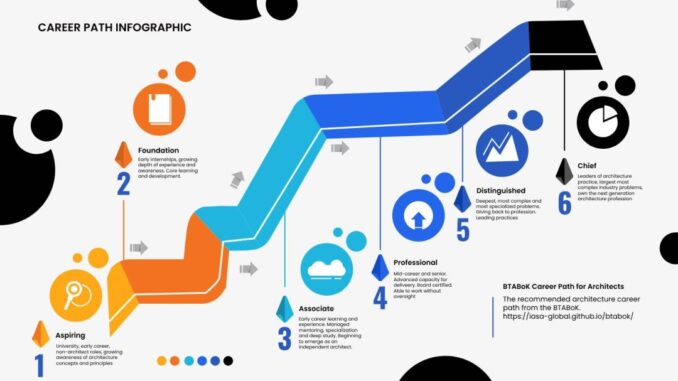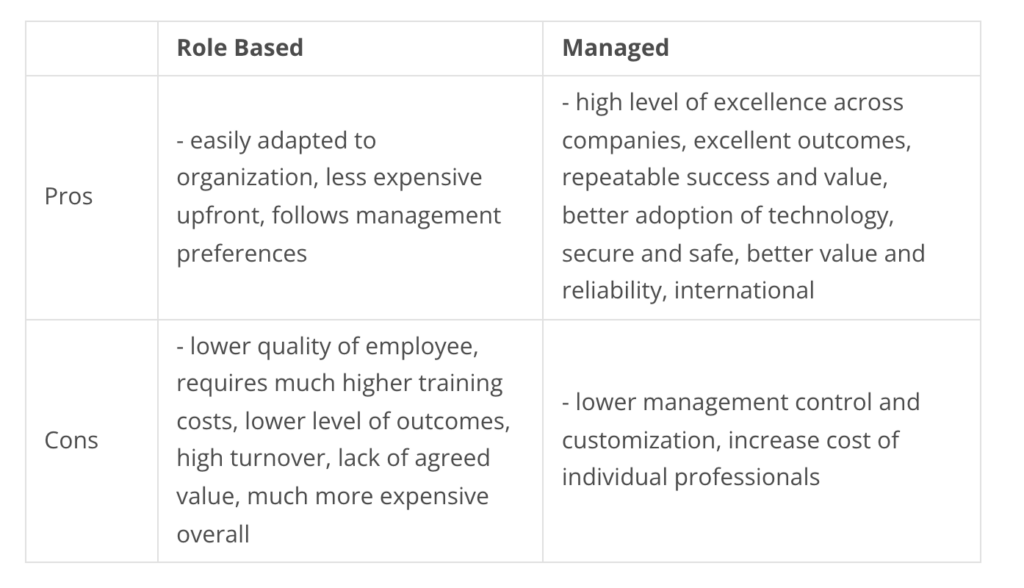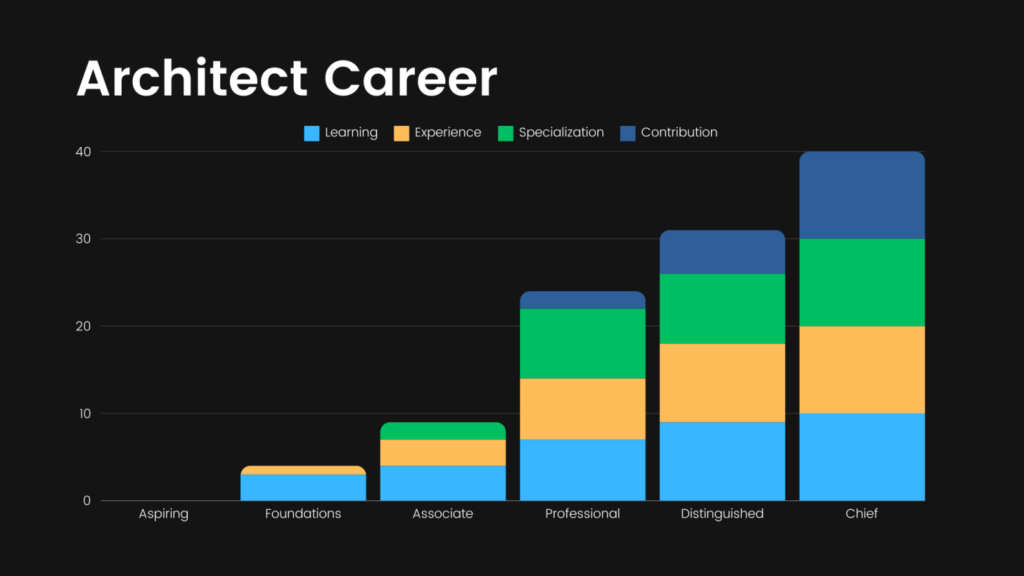
By Paul Preiss
The question of career path is deeply important to architects. It determines many of the qualities which allow them to perform well in their expected jobs. Some jobs become managed from when they are founded and some remain role-based. The determining factors for this from research in the field of professions* seems to be:
- Importance of the job to safety, financial outcomes or societal impacts
- Liability and security related to the execution and outcome of professional decisions.
- The group desire of the professionals to maintain minimum competency standards. Normally this results from a desire to keep quality and pricing manageable.
- External requirements such as governments, standards or other that demand certain levels for certain jobs.
For those jobs to be similar in nature and activity across employers and for employers to be able to hire reasonably qualified individuals into the role. There are a set of tradeoffs from either approach to architect career path.

The Case for a Managed Career Path for Architects
There are benefits in both random (current) and managed (future) career paths. The case for making architecture a managed profession stems from a few critical factors:
- Rising Levels of Societal Impact: The impact of technology is growing daily. This impact and difficulties of technology, not just threats but the daily interaction of people with technology like subscription models, social media, passwords, banking etc, is increasingly important to the average person. This rising friction with individuals creates a demand for trusted professionals in similar ways to medicine and law. While the average person will likely not hire an architect soon, society is in need of the trust that profession creates to ensure that corporate interests or complexity do not rule their lives.
- Regulatory Pressure: Increasing pressure is coming to bear on all aspects of technology as it relates to government and regulation. From things like sustainability, privacy and accountability to impacts to purchasing, monopolies, identity and security. The more prevalent technology becomes in society, the more regulation that needs to be met to ensure appropriate use. In all industries where this level of regulation exists, professionals rise to meet the challenge and guide clients through the process. Doing so while creating value for clients and employers is the art and the science of architecture.
- New Technology Opportunities/Threats: Avoiding catastrophes in both small and large scopes is one function of modern professions. Non-professionals are not allowed to play with dangerous research or deploy dangerous products in most fields. For example, laypeople are not allowed to do bio-research or build complex structures (buildings) because they can harm people. The rise of the use of internet, AI, mobile platforms, and even social media and identity can harm both individuals and society. These threats are emerging faster and faster and it has become essential to have professionals to understand their implications before they are simply released to regular people or companies. In addition to threats, most organisations are not able to realize the benefit of new technologies in a repeatable way. Agility, AI, Cloud, Mobility, Digital Transformation, Manufacturing and OT, and much much more continuously suffer from poor results primarily due to lack of educated, experienced and capable teams and leaders. Architects are one of the critical professions to ensure that changes (engineering and other must also mature). The randomised backgrounds and skill sets of role-based architects are unlikely to be able to scale to achieve these needed results.
- Severe Demand/Quality Problems: The demand for high-quality architecture professionals is growing daily. This demand can no longer be met in the role-based education methods that were developed in the early rush of the 90’s. At that time each employer educated its own people, especially in places like consulting companies which sold architect hours. The current world has tens if not hundreds of thousands of opportunities where a skilled architect is needed and yet no consistent method of generating them. This gets worse if you consider that each of those employers emphasizes different skills in their workforce and role. This makes it extremely important to create a consistent and repeatable method for generating architects globally. This goes far beyond simple framework education which we have relied on to date. To generate 10,000 skilled and experienced architects requires a major set of initiatives across large numbers of employers. It is even also important that this be externally managed by the professionals themselves so that corporate interests do not negate the benefits. Due to this demand growth and the likelyhood that it will continue for many decades it becomes very important that a managed profession help meet those demands.
Benefits of a Managed Profession
- Excellence at all Levels: It is familiar to expect excellence in a professional. Doctors, lawyers, accountants and other managed professions are expected to provide excellence. BT Architecture is no different when using a managed career path. Expecting people skills, business skills and technical skills at certain levels of competency can become an expectation in this method.
- Increased Value: With a common definition of value. A common and well understood suite of tools and a standard of excellence, any group of professionals will deliver high value outcomes. This includes reduced risk as well and increased direct outcomes in both business and technical terms. An organization has the right to expect this level of repeatable success no matter which architect or which type of architect they work with.
- Better Adoption of Technology: The industry continually struggles to adopt even basic changes to practice. From cloud (native) to agility, AI, sustainability and integration, the lack of skill and the lack of awareness are constantly sited as the reasons behind failure. By managing professional credentials externally on a rigorous career path and competency model, industry can more stably adapt to new technologies in both a beneficial and safe way.
- International: The BT architecture profession is one where companies are as likely to work with an international set of professionals as local ones. This means the standard of excellence must be similar in all countries. This becomes impossible in a single organization. However an externalized and recognized profession can drastically increase the opportunities there.
Benefits of the role-based career path:
- Easily adapted: In the role-based career path it is very easy to adapt the career to an organization as there are no requirements for its formation or structure. For example if one company wants to have business architects doing programming and another wants to have chief architects doing business capabilities, that is completely up to them. This obviously comes
- Less Expensive Upfront: In role-based careers the profession can be adapted to whatever the company can afford to pay. The company can decide training levels, experience and engagement level. This makes it easy to begin doing some architecture without the overhead of the higer expense/higher skilled model.
- Follows Management Preferences: The role-based career path is based on the preferences and desires of management so it can be run in a much more customized way at least as long as individuals are found who are willing to do the work.
Tradeoffs of Role-based Career Paths
- Increased Risk/Decreased Value: In the role-based career path it is very easy to adapt the career to an organization as there are no requirements for its formation or structure. For example if one company wants to have business architects doing programming and another wants to have chief architects doing business capabilities, that is completely up to them.
- Higher Training Cost: In role-based careers the profession can be adapted to whatever the company can afford to pay. The company can decide training levels, experience and engagement level. This makes it easy to begin doing some architecture without the overhead of the higer expense/higher skilled model.
- High Turnover/Low Satisfaction: When architecture is a management-defined activity as opposed to a professional one, the practitioners are often severely disappointed with the role. Surveys indicate that most architects are deeply disconnected from their current practice models as they do not mirror the expected job activities and value proposition that architects are expected to perform.
- More Expensive: In the long run, architecture practices using this model appear to be much more expensive than a managed profession when measured against similar quality outcomes. It follows the old adage, “You can’t afford to do it right, but you can afford to do it twice.”
Managed career path has almost the opposite characteristics of the role-based career. A managed professional will move significantly faster to excellence in the field and the overall profession will hold much higher value outcomes for its clients. Think of the difference in medicine after the establishment of professional levels.
BTABoK Approach

- Architecture is a a profession meant to aid in the delivery (execution) of business technology strategy. By this we mean that requires a consistent structure of knowledge and specific set of competencies which are defined and measurable to achieve its value to society.
- The value of the profession and the effects it has on society, corporate interests and safety are high enough to demand a professionally managed career path.
- Specializations are supported in a variety of instances and work together to fulfil these needs for large engagement models.

Competency and Concept Groupings
This article is a part of the full career path article being authored in the BTABoK repository at https://iasa-global.github.io/btabok/
